Thursday 16 May 2024
17 Foods with More Protein Than an Egg to Boost Your Meals
10 Best Snacks for Gut Health, According to Dietitians
Taking care of your gut is more important than many people realize. A healthy gut means healthy digestion, but it is connected to so much more. Gut health is linked to your immune system, brain function, heart health, and even your mental well-being. One of the best, most foundational ways to care for this part of your body is by incorporating more gut-healthy foods into your diet.
The food you consume has an enormous impact on the state of your gut. Foods that are high in fiber, unsaturated fats, and probiotics can improve your gut microbiome (the ecosystem of bacteria that live within your gut). Conversely, ultra-processed foods that are high in added sugars and saturated fat, as well as alcoholic beverages, can damage gut health.
When it comes to incorporating nourishing foods into your diet, snack time is an easy place to start. If you can find some gut-healthy snacks you enjoy eating between meals, you can work toward improving your gut microbiome and reaping all the
Yogurt and berries
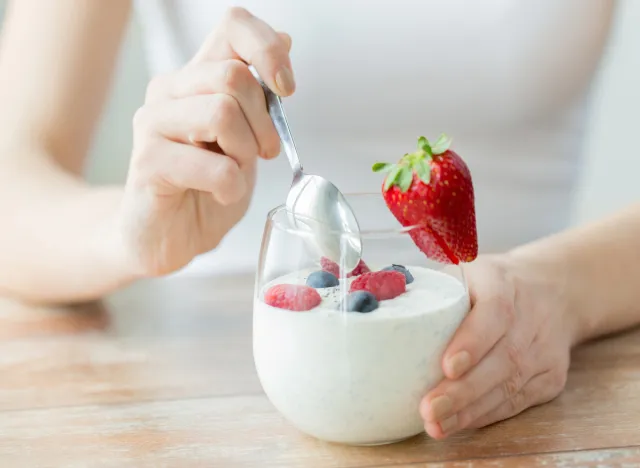
"Yogurt is celebrated as a gut-friendly snack due to its rich probiotic content, which introduces beneficial bacteria to the digestive system," says Manaker. "These probiotics play a crucial role in balancing the gut microbiome, aiding in digestion, and boosting the immune system."
You can eat your yogurt as is, or you can add some of your favorite berries for even more gut-health benefits. Berries are rich in antioxidants called polyphenols, and research shows that polyphenols can positively impact your gut microbiome and help reduce inflammation.
Hummus and carrots
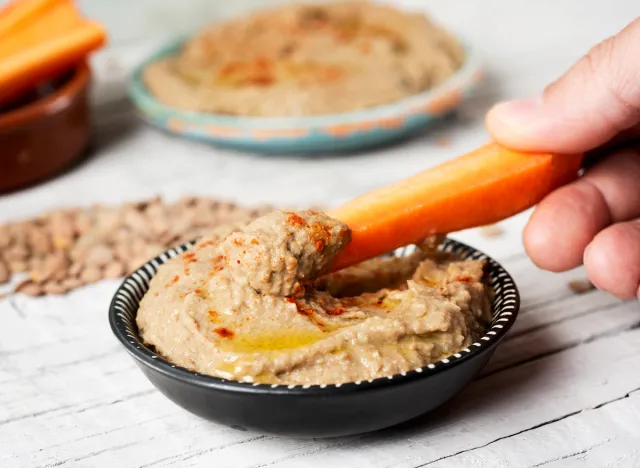
Hummus paired with carrot slices emerges as yet another commendable snack for gut health, tapping into the benefits brought forth by its fiber-rich composition and the presence of health-enhancing legumes," says Manaker.
"Hummus, primarily made from chickpeas, tahini, olive oil, and garlic, is not only a delicious and creamy spread but is also a nutrient powerhouse," says Manaker. "Chickpeas are high in dietary fiber, which supports digestive health by promoting bowel regularity and fostering a healthy gut microbiome. Additionally, the fiber in chickpeas acts as a prebiotic, feeding the good bacteria in the gut, which is crucial for maintaining a balanced digestive system."
She also notes that carrots, which are high in fiber and a plant pigment called beta-carotene, "complement hummus by providing an extra fiber boost and an array of vitamins and minerals."
"Altogether," she adds, "hummus and carrot slices are a synergistic snack that promotes gut health while simultaneously offering a satisfying blend of textures and flavors."
Almonds
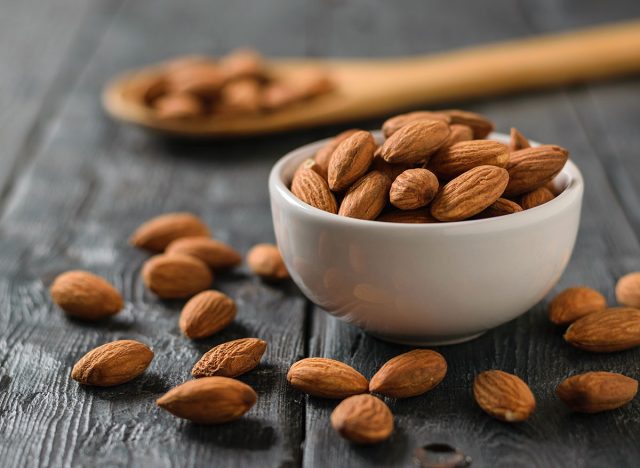
Almonds are, hands down, one of the healthiest foods you can snack on. Whether you're eating them on their own, putting them in your yogurt, or making your own trailmix, this nut can benefit your skin health, help with weight management, and yes, can even help improve your gut health.
According to a study published in Current Developments in Nutrition, almonds contain good amounts of unsaturated fats, fiber, and polyphenols (a type of plant compound that acts as an antioxidant), which help make them extremely beneficial to the health of your gut microbiome. Another study, published in the American Journal of Clinical Nutrition, found that consuming almonds can help increase a fatty acid called butyrate, which can help protect your colon lining and directly improve gut health.
Kefir smoothie
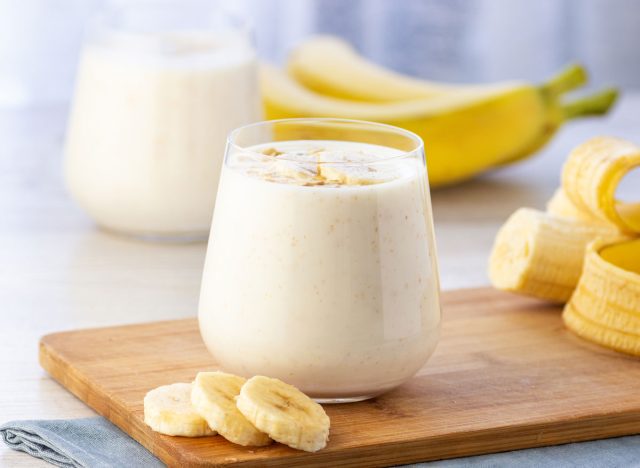
Kefir is a fermented milk product with a texture somewhere between milk and yogurt, and because it's fermented, it carries a ton of gut-healthy probiotics for you to enjoy.
"This fermented milk drink is made by adding kefir grains to milk, resulting in a rich concoction of beneficial bacteria and yeast," says Manaker. "The fermentation process not only increases the probiotic content but also makes kefir a rich source of lactase, an enzyme that breaks down lactose, thereby reducing symptoms of lactose intolerance in individuals." She adds, "The probiotics in kefir help maintain the natural balance of the gut microbiome, effectively aiding in digestion and bolstering the immune system."
With all of these gut benefits, it's a great idea to incorporate kefir into your snacks when you can. One way you can do this is by making a kefir smoothie! Swap out your milk for this fermented drink, and you'll have a creamy smoothie full of flavor and great for your gut!
Popcorn
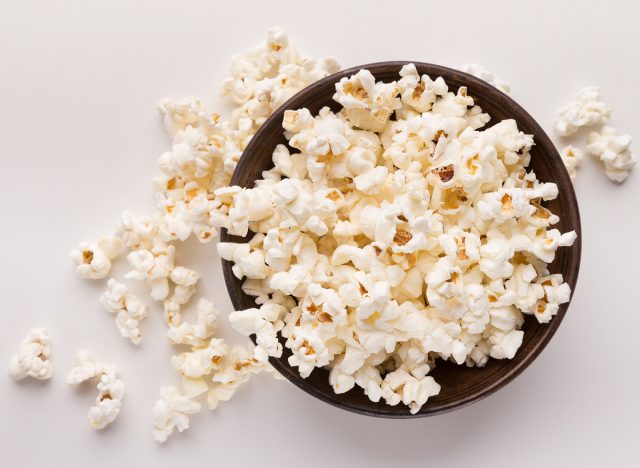
Popcorn lovers can rejoice that this savory snack may have very powerful gut health benefits. Popcorn is naturally high in soluble fiber, which can help regulate and improve the health of your gut microbiome.
However, before you start snacking, it's important to find a healthy popcorn brand you can enjoy (whether it's bagged or microwaved) that doesn't contain potentially gut-harming ingredients. For instance, some microwave popcorn brands are high in saturated fat, and consuming excess amounts of this fat can negatively impact your gut microbiome.
Sliced avocado wrapped in nori
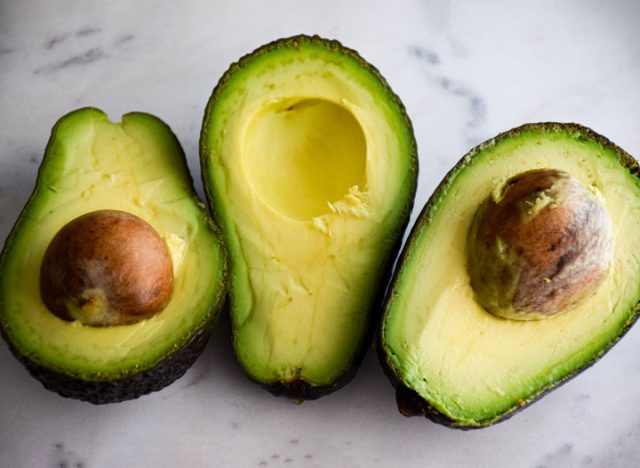
This may be a snack you've never heard of, but Manaker suggests a delicious, gut-healthy snack of avocado slices wrapped in nori—a type of dried seaweed packed full of nutrients.
"Sliced avocados wrapped in nori sheets emerge as an innovative snack for enhancing gut health, chiefly due to the unique combination of fiber from avocados and prebiotics found in nori," says Manaker. "Avocados are high in soluble fiber, which facilitates the growth of healthy bacteria in the gut, thereby supporting the digestive process and promoting bowel regularity. Nori, a type of seaweed, is rich in polysaccharides that act as prebiotics, substances that feed beneficial gut bacteria."
She notes, "This synergy not only aids in maintaining a balanced gut microbiome but also contributes to the snack's nutrient density, offering vitamins, minerals, and healthy fats, thus making it an exceptional choice for gut health and overall nutritional balance."
Chia pudding
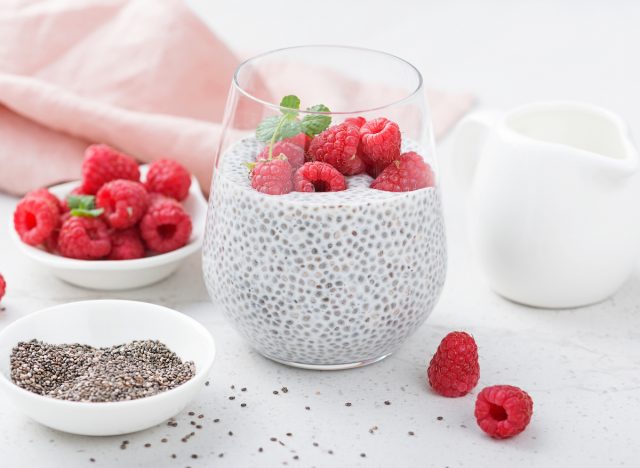
Chia seeds are high in fiber and healthy fats, both of which can help improve the health of your gut. These small seeds are powerful, but you can't really eat them on their own! Some people put chia seeds in their yogurt, smoothie, or even their water, but we love snacking on a tasty chia pudding—especially because you can make it ahead of time and save it for when you need a quick and healthy snack on the go.
You can make chia seed pudding by using your favorite milk, yogurt, and toppings like nuts, nut butter, and fruit. For inspiration, check out this easy, customizable overnight chia pudding recipe.
Apple with nut butter
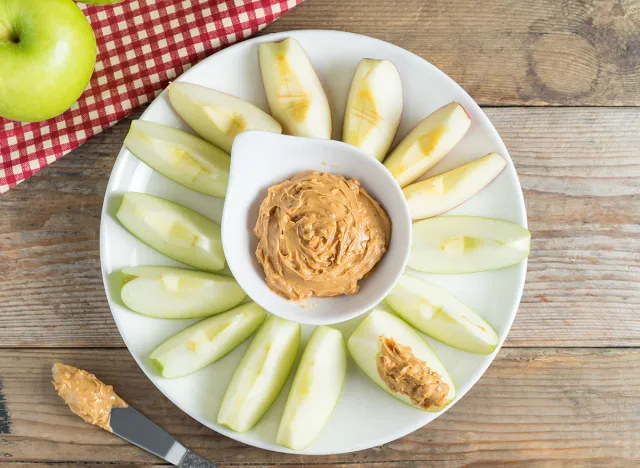
Grab an apple and your favorite nut butter, because research shows this nostalgic snack can do wonders for your gut health.
Apples contain fiber, specifically pectin, which studies have shown can help improve the gut microbiota. Pairing apple slices with your favorite nut butter can also bring in more fiber and healthy fats, which are two nutrients that can also help improve your gut.
Roasted lentils
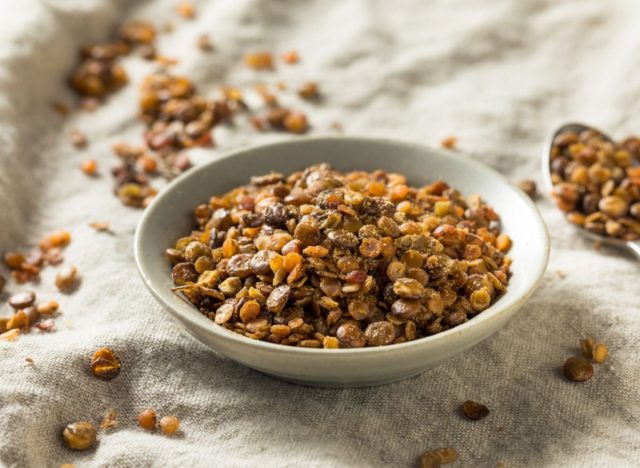
When you want a bit of a crunchy snack that still provides your body with gut-healthy nutrients, Manaker suggests roasting some lentils.
"Roasted lentils are an excellent snack for enhancing gut health because of their high fiber content and nutrient density," she says. "Lentils, being legumes, are loaded with both soluble and insoluble fiber, and this fiber aids in promoting healthy bowel movements and preventing constipation, thereby maintaining a healthy digestive system."
She adds, "Lentils are also a great source of plant-based protein and essential minerals like iron and magnesium, which contribute to overall health and wellness. When roasted, their versatility and satisfying crunchy texture make them an appealing snack that supports gut health while being delicious to consume."
High-fiber cereal
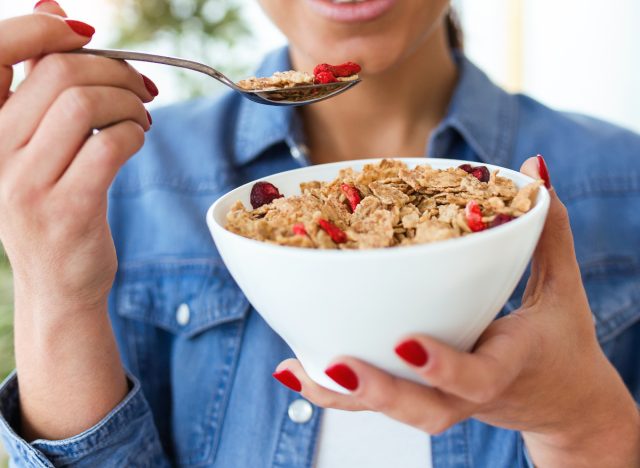
Many popular cereal brands out there are full of added sugars and contain very little fiber, but there are healthier, high-fiber cereals you can find on grocery shelves.
You may mainly associate cereal with breakfast, but when you find a brand you love that has plenty of fiber, it can make for a great snack to help with your gut health goals. Not only that, but cereal fiber and whole grains, in general, can help reduce the risk of chronic disease, diabetes, and cardiovascular disease.
30 Foods That Can Help Unclog Your Arteries
The number one killer in the United States is heart disease: According to the Centers for Disease Control and Prevention (CDC), 610,000 people die from it every year—that is about one out of every four deaths. The cause of heart disease is generally clogged arteries. These blood vessels can be blocked by fatty plaque that contains calcium, cholesterol, and other substances that circulate in the blood. “There is no one magic food that acts like Drano and cleans out the accumulated plaque,” says Florian Rader, MD, a cardiologist at the Smidt Heart Institute at Cedars-Sinai Medical Center in Los Angeles. “But good habits can help slow down that process, and maintaining a healthy weight and diet is one factor you can control to a great degree. And,” he says, “It’s never too late to start.”
Oats
Here’s a step forward in helping your arteries: It’s been more than 20 years since the FDA approved heart-healthy claims for these whole grains, and research keeps uncovering new benefits. The main one, says Bonnie Taub-Dix, RD, author of Read It Before You Eat It: Taking You from Label to Table, is their rich supply of soluble fiber, which has been shown to lower bad LDL cholesterol levels. Why that’s good for your arteries, according to Dr. Rader: “Cholesterol can seep into the inner layer of blood vessels and form plaque over time.” Since most Americans fall chronically short on fiber, the four grams per cup that oats deliver are a welcome addition.
Beans
A great source of soluble fiber—black beans have three times as much of it per cup as oats. Another perk: Antioxidants, which are especially abundant in colorful varieties such as black beans and red kidney beans, may fight inflammation that contributes to heart disease.
Lentils
These protein-packed discs come from the same legume family as beans, which means that they pack many similar benefits. Preliminary research in rats found that lentils appear to reverse the damage to blood vessels caused by high blood pressure. Plus, lentils are at the top of the food spectrum for protein and fiber content, with very little fat, and contain calcium, potassium, and magnesium—all minerals that can help lower blood pressure. Find out the best and worst diets for heart health.
Fish
A lot of the research on omega-3 fatty acids focuses on brain health, but these potent anti-inflammatories have benefits for your ticker, too. Research links inflammation inside your body to a number of chronic diseases and conditions, including plaque buildup, says Dr. Rader. So there’s speculation that reducing inflammation might reduce plaque in your arteries. Eating fatty fish such as salmon and mackerel is one way to get your fill of omega-3s, so try to eat some at least twice a week, says Taub-Dix.
Avocados
Fat of any kind used to be at the top of the list of things that are bad for your heart. Not anymore: Research reveals that mono- and polyunsaturated fats, like those found in avocados, are heart-healthy because they help lower bad LDL cholesterol and raise good HDL cholesterol, says Taub-Dix. These green fruits also contain a decent amount of fiber. Read more about the heart-healthy benefits of avocados.
Pistachios
Nuts are another good source of heart-healthy fats, and pistachios have this bonus: They’re filled with plant sterols, the same substances in cholesterol-lowering products that help block cholesterol absorption in your gut, says Karen Ansel, RD, author of Healing Superfoods for Anti-Aging: Stay Younger, Live Longer. If you’re allergic to nuts, you can also get plant sterols from sesame seeds.
Turmeric
In recent years, more people have started recognizing the health-boosting properties of this brilliant yellow spice traditionally used in Indian cuisine. A substance in the spice, curcumin, is an antioxidant that may help prevent fatty deposits from building up and blocking arteries, Ansel says. If you’re not a huge fan of curry, try a golden latte made with the spice.
Broccoli
Scientists have known for years that cruciferous veggies like broccoli have cancer-fighting abilities, but researchers are also examining broccoli’s role in heart health. There’s evidence that a compound in it called sulforaphane may assist the body’s natural defenses against arterial clogs by activating a certain kind of protein, says Ansel. Broccoli also has fiber and anti-inflammatory properties.
Asparagus
Another green giant as far as heart health goes, these fibrous stalks are rich in quercetin, a phytonutrient that prevents plaque from sticking to your arteries. “Whether you have a family history of heart disease or are simply trying to prevent it, asparagus should be at the top of your shopping list,” Ansel says.
Watermelon
The reason cardiologists seem obsessed with taking your blood pressure? When it’s elevated, it can eventually wear out the lining of your blood vessels, leaving them less elastic and able to function normally. That can increase your risk for a heart attack or stroke. This juicy melon can help. “Watermelon is the number one source of citrulline,” says Ansel. Citrulline is an amino acid the body uses to produce nitric oxide, which may help keep blood vessels relaxed and pliable.
Whole grains
You may have the impression that carbs aren’t good for you, but that isn’t true. Whole grains—even in bread and pasta—are part of a heart-healthy diet. According to an analysis published in the Archives of Internal Medicine, for every 10 grams of whole grains people eat each day, their risk of heart disease dropped 14 percent; even better, their odds of dying from a heart attack fell 25 percent. This may be because whole grains are loaded with fiber, says Angela Lemond, RDN, a Plano, Texas-based nutritionist and national spokesperson for the Academy of Nutrition and Dietetics. “Fiber helps pull cholesterol out of the body. It is also known to help promote the growth of good bacteria in the gut, which can have an indirect benefit on heart health.” Try swapping refined grains for unprocessed ones to reap the benefits.
Milk with DHA
As aging arteries stiffen up, says Lemond, they can begin to restrict your blood flow. Omega-3 fatty acids promote cardiovascular health—especially one known as docosahexaenoic acid (DHA). It’s most commonly found in seafood, but if you’re not a fish fan, try DHA-fortified milk and eggs.
Potatoes
Yes, you can have potatoes. Spuds are full of potassium: They give you more than double the amount in an average banana. That’s key because less than 2% of Americans are getting their recommended daily amount of potassium, and it’s helpful in regulating your blood pressure. Potatoes also have a decent amount of fiber, so as long as you don’t deep-fry them or slather them in butter and sour cream, they can be a surprisingly healthy choice
Chocolate
How to help your arteries? Consider some chocolate. Cocoa beans are rich in flavanols—plant compounds that have antioxidant properties and may benefit your heart. A 2017 analysis of the research done on chocolate published in the journal Nutrients found that people who regularly ate chocolate (in moderation) had a lower risk of heart failure. Nutritionists recommend dark chocolate over other types—that high cacao percentage (above 70 percent) means the bar has more beneficial compounds.
Coffee
Like a lot of beans, coffee beans—and the java you get from them—deliver healthy antioxidants. In research, coffee seems to have potential to lower the risk of cardiac disease; the caffeine may also help your ticker. When scientists recently gave mice the caffeine equivalent of four cups of coffee, they discovered that the cells lining the mice’s blood vessels began to work more efficiently.
Wine
While most nutritional guidelines acknowledge that a little wine (and other types of alcohol) in moderation may be good for your heart, they do so with a strong caution, says Dr. Rader. He points out that there’s no direct cause and effect—researchers haven’t established that drinking wine lowers your risk; they only know that people with a lower risk of heart disease tend to drink wine. That’s why no one is handing out free passes to drink as much as you want: Limit yourself to no more than one four-ounce glass of wine a day if you’re a woman—two for men. Keep in mind you might get similar benefits with any type of alcohol.
Eggs
Heart specialists used to warn people to stay away from eggs because they have a lot of cholesterol. But the research suggests that the cholesterol in your food doesn’t have that much of an impact on the levels in your blood, says Taub-Dix. In fact, fats in eggs seem to boost the good HDL cholesterol in your blood (it helps prevent the buildup of plaque in vessel walls). A study conducted in China and published in the journal Heart suggested that a moderate intake of eggs (less than one a day) was associated with an 11 percent lower risk of heart disease compared with never eating them.
Berries
They’re fiber- and antioxidant-rich, and one study, published in Circulation: The Journal of the American Heart Association, found that eating three servings a week may reduce the risk of a heart attack by a third in women. Researchers credit anthocyanins, compounds in berries that may help dilate blood vessels, making it easier for blood to pass through.
Green tea
Benefits abound in this brew—and British researchers found a potential new bonus: They were focusing on a compound known as EGCG, which has shown promise in treating Alzheimer’s disease. The researchers found that the same molecule could shrink fatty deposits on artery walls. In previous research, scientists demonstrated that green tea could lower bad LDL cholesterol and triglycerides, too.
Fermented foods
Probiotics get a lot of attention because they support the populations of healthy bacteria in your gut. But did you know that you can repopulate your intestines with the good healthy bacteria found in foods like kimchi, yogurt, tepache and kombucha? Emerging research indicates that the foods (and the bacteria they contain) may help lower your blood pressure and bad LDL cholesterol levels.